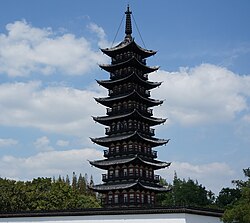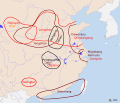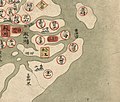|
Songjiang, Shanghai
Songjiang is a suburban district (formerly a county) of Shanghai. It has a land area of 605.64 km2 (233.84 sq mi) and a population of 1,909,713 (2020).[1][2] Owing to a long history, Songjiang is known as the cultural root of Shanghai. Songjiang Town, the urban center of the district, was formerly the major city in the area. It is now connected to downtown Shanghai by Line 9 of the Shanghai Metro. HistoryThe prehistoric coastline of the East China Sea was much farther inland, at Xinzhuang near Songjiang's current eastern border with Minhang District. It was only gradually that silt from the Yangtze River filled in downtown Shanghai about 2000 years ago and then Pudong and Chongming Island over the last 1000 years. Modern archaeology has established a chronology of the main cultural groups who lived in the present area of Songjiang District in Neolithic China: the Majiabang in the 5th millennium BC), the Songze in the 4th millennium BC), and the Liangzhu in the 3rd millennium BC. The Majiabang were among the first harvesters of rice and kept domesticated pigs while still frequently hunting deer. The Liangzhu possessed a high stratified society that almost certainly represented one of the earliest states in East Asia. The Liangzhu site at Guangfulin in Songjiang has been developed into Guangfulin Relics Park, an expansive museum and tourist attraction.
Traditional Chinese historiography only recorded these people as among the Baiyue—the "Numerous Southern Barbarians"—until the growth of the siniticized Wu Kingdom at Suzhou in the 1st millennium BC. During the Spring and Autumn period at the end of the Zhou and under the Warring States, the area of present-day Songjiang passed from Wu to Yue to Chu before the unification of China under Shi Huangdi of Qin in the 3rd century BC. In the Three Kingdoms period that followed the end of the Han in the 3rd century AD, Sun Quan's Wu Kingdom helped develop and further sinify the area. Another boost came from the completion of the Grand Canal under the Sui, linking Songjiang with Hangzhou, Shaoxing, and Ningbo in the south and Suzhou, Luoyang, Xi'an, and Beijing in the north. By the mid-Tang, the region had developed enough that it was organized in 751 into Huating County, the first county-level administration within modern-day Shanghai.
In the 1250s at the end of the Southern Song, the 10-year-old Songjiangese girl Huang Daopo fled her hometown and an arranged marriage to live with the Hlai on Hainan. She returned around 1295 with new strains of cotton, an early cotton gin, and other advances to cotton cultivation and processing that made the sandy lands of eastern Huating County so much more prosperous that Huang was later deified out of gratitude. By the mid-Qing, as much as ¾ of Songjiang's farmland was devoted to cotton.[3] Under the Yuan, this new wealth saw Huating elevated to prefectural status and renamed Songjiangfu. This is sometimes considered the origin of China's modern textile industry. It was also under the Yuan that the city first had enough Hui to establish Shanghai's first mosque.
In 1404, headwaters previously emptying into the Wusong were rerouted by local officials, diminishing the size of Suzhou Creek and expanding the Huangpu River to its modern importance. Songjiang was better fortified under the Ming in response to attacks by the Japanese "Wokou" pirates, who sometimes raided and sometimes occupied to the town. The Ming also saw the Jesuits—who counted the influential Shanghainese official Xu Guangqi among their converts—establish the town's first known church. Owing to the importance of Portuguese and Latin at the time, the town's name was romanized Sumkiam.
Following Dorgon's 21 July 1645 edict mandating the queue, the people of Songjiang rose up against the Qing to protect their hair, viewed as a symbol of virility and filial piety. Li Chengdong (李成東, d. 1649) retook the city and massacred its population on 22 September 1645. Nonetheless, Songjiang remained the primary metropolis of the area of present-day Shanghai as late as the mid-19th century, when its name was typically romanized as Sungkiang. It continued to serve as the prefectural capital under the "Right" Governor of Jiangnan based in Suzhou and then later under the governor of Jiangsu at Jiangning (now Nanjing). Unlike the foreign-held area of Shanghai, however, it fell to rebels during the Taiping Rebellion's Eastern Expedition. About a hundred Europeans under Frederick Townsend Ward failed to retake the town in June 1860. After gathering more Westerners, over 80 Philippine "Manilamen", and several pieces of artillery, a second assault in July 1860 retook the town with heavy losses. Out of about 250 men, 62 were killed and about 100 wounded, including Ward. Songjiang was then used by Ward, Henry Andres Burgevine, their Ever-Victorious Army, and Cheng Xueqi's division of the Huai Army as a base for raids and attacks on other Taiping positions under Li Xiucheng throughout the "Battle of Shanghai". Despite Shanghai's greater importance by the beginning of the 20th century, its international settlement meant Songjiang was still used as the formal center of Chinese government for the region. Under the Republic of China, the Zhili clique leader Sun Chuanfang's Songhu (淞滬市) or Songjiang Special Administrative District covered most of what is now Shanghai Municipality, extending as far north as Chongming Island.[4]
During World War II, Japan occupied Songjiang from 9 November 1937 until 1945. Afterwards, both the Nationalist and Communist regional government was moved to Shanghai proper, leaving Songjiang a comparatively rural county. The city's many ancient religious structures and examples of traditional architecture were seriously damaged during the 1960s and 1970s amid the Cultural Revolution. Following the PRC's Opening Up Policy, Songjiang restored its more important religious buildings and developed into a college town hosting several large universities. In 1998, it was elevated to its current status as an urban district. Significant FeaturesSome of the notable features in Songjiang District include:
Cultural sights in Songjiang include:
Government and infrastructureThe Shanghai Women's Prison is in Songjiang District.[7] TransportSongjiang District is located approximately 25 kilometers (16 mi) from Hongqiao International Airport and 70 kilometers (43 mi) from Pudong International Airport. Songjiang is currently served by one metro line operated by Shanghai Metro, one suburban line operated by China Railway, and two tram lines. Metro
Suburban RailChina RailwaySongjiang TramSubdistricts and townsSongjiang District has six subdistricts, eleven towns and three special township-level divisions.
Climate
AttractionsXilin Chan Temple is a Buddhist temple in Yueyang Subdistrict, which is also a famous tourist attraction. Zuibaichi is one of the five ancient Chinese gardens in Shanghai that dates back to the Song dynasty. The Songjiang Mosque is the oldest mosque in Shanghai with its latest rebuild in 1391. Songjiang's emblematic tower is the 9-story Fangta Pagoda, or Songjiang Square Pagoda. Dacang Bridge is a historic stone arch bridge over the Old City River in the district. Songjiang Tangjing Building is located in the Zhongshan Primary School, Songjiang District and it is the oldest surviving above-ground relic in Shanghai built in 859 AD. Sheshan Basilica is a Roman Catholic church built on Sheshan Hill in the Romanesque architectural style. Originally constructed in 1863, the current church was finished in 1935. Notable peopleBirthplace:
Heroes: Hou Shaoqiu, Jiang Huilin, Xia Yunyi, Chen Zilong, Xia Wanchun; Statesmen: Gu Yong, Lu Xun, Xu Jie; Litterateurs: Lu Ji, Lu Yun, Chen Jiru, Qian Fu, Gu Qing; Chinese Painting and Calligraphy (Songjiang was listed among "cities of Calligraphy" in 2013[13]) Artists: Shen Du, Dong Qichang, Zhang Nanheng, Zhang Zhao, Shi Zhecun, Cheng Shifa; Craftsmen: Zhu Kerou, Huang Daopo, Ding Niangzi; Experts: Tao Zongyi, Zhu Shunshui, Chen Yongkang; Educators: He Dong, Ping Hailan, Ma Xiangru; Intelligent woman: Ye Gu. References
Further reading
External linksWikimedia Commons has media related to Songjiang District. Wikivoyage has a travel guide for Songjiang District. |
|||||||||||||||||||||||||||||||||||||||||||||||||||||||||||||||||||||||||||||||||||||||||||||||||||||||||||||||||||||||||||||||||||||||||||||||||||||||||||||||||||||||||||||||||||||||||||||||||||||||||||||||||||||||||||||||||||||||||||||||||||||||||||||||||||||||||||||||||||||||||||||||||||||||||||||||||||||||||||||||||||||||||||||||||||||||||||||||||||||||||||||||||||||||||||||||||||||||||||||||||||||||||||||||||||||||||






















